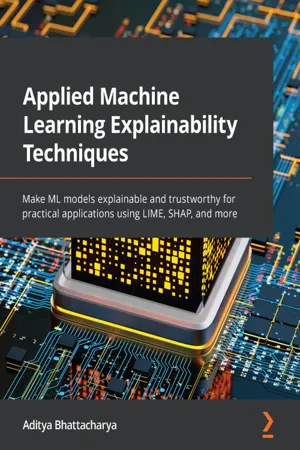
- 304 pages
- English
- ePUB (mobile friendly)
- Available on iOS & Android
Applied Machine Learning Explainability Techniques
About this book
Leverage top XAI frameworks to explain your machine learning models with ease and discover best practices and guidelines to build scalable explainable ML systemsKey Features• Explore various explainability methods for designing robust and scalable explainable ML systems• Use XAI frameworks such as LIME and SHAP to make ML models explainable to solve practical problems• Design user-centric explainable ML systems using guidelines provided for industrial applicationsBook DescriptionExplainable AI (XAI) is an emerging field that brings artificial intelligence (AI) closer to non-technical end users. XAI makes machine learning (ML) models transparent and trustworthy along with promoting AI adoption for industrial and research use cases.Applied Machine Learning Explainability Techniques comes with a unique blend of industrial and academic research perspectives to help you acquire practical XAI skills. You'll begin by gaining a conceptual understanding of XAI and why it's so important in AI. Next, you'll get the practical experience needed to utilize XAI in AI/ML problem-solving processes using state-of-the-art methods and frameworks. Finally, you'll get the essential guidelines needed to take your XAI journey to the next level and bridge the existing gaps between AI and end users.By the end of this ML book, you'll be equipped with best practices in the AI/ML life cycle and will be able to implement XAI methods and approaches using Python to solve industrial problems, successfully addressing key pain points encountered.What you will learn• Explore various explanation methods and their evaluation criteria• Learn model explanation methods for structured and unstructured data• Apply data-centric XAI for practical problem-solving• Hands-on exposure to LIME, SHAP, TCAV, DALEX, ALIBI, DiCE, and others• Discover industrial best practices for explainable ML systems• Use user-centric XAI to bring AI closer to non-technical end users• Address open challenges in XAI using the recommended guidelinesWho this book is forThis book is for scientists, researchers, engineers, architects, and managers who are actively engaged in machine learning and related fields. Anyone who is interested in problem-solving using AI will benefit from this book. Foundational knowledge of Python, ML, DL, and data science is recommended. AI/ML experts working with data science, ML, DL, and AI will be able to put their knowledge to work with this practical guide. This book is ideal for you if you're a data and AI scientist, AI/ML engineer, AI/ML product manager, AI product owner, AI/ML researcher, and UX and HCI researcher.
Frequently asked questions
- Essential is ideal for learners and professionals who enjoy exploring a wide range of subjects. Access the Essential Library with 800,000+ trusted titles and best-sellers across business, personal growth, and the humanities. Includes unlimited reading time and Standard Read Aloud voice.
- Complete: Perfect for advanced learners and researchers needing full, unrestricted access. Unlock 1.4M+ books across hundreds of subjects, including academic and specialized titles. The Complete Plan also includes advanced features like Premium Read Aloud and Research Assistant.
Please note we cannot support devices running on iOS 13 and Android 7 or earlier. Learn more about using the app.
Information
Table of contents
- Applied Machine Learning Explainability Techniques
- Contributors
- Preface
- Section 1 – Conceptual Exposure
- Chapter 1: Foundational Concepts of Explainability Techniques
- Chapter 2: Model Explainability Methods
- Chapter 3: Data-Centric Approaches
- Section 2 – Practical Problem Solving
- Chapter 4: LIME for Model Interpretability
- Chapter 5: Practical Exposure to Using LIME in ML
- Chapter 6: Model Interpretability Using SHAP
- Chapter 7: Practical Exposure to Using SHAP in ML
- Chapter 8: Human-Friendly Explanations with TCAV
- Chapter 9: Other Popular XAI Frameworks
- Section 3 –Taking XAI to the Next Level
- Chapter 10: XAI Industry Best Practices
- Chapter 11: End User-Centered Artificial Intelligence
- Other Books You May Enjoy